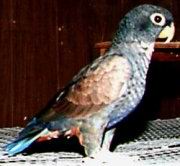Piones - Blue headed, Paler
Paler Blue Headed Parrot Scientific Name: Pionus menstruus rubrigularis
Fri, 4th July, 2025 - 9:52 am GMT
Sponsor Ads:

Alternative Name
Paler Blue Headed Parrot Scientific Name: Pionus menstruus rubrigularisBasic Info
The Paler Blue Headed Pionus is not sexually dimorphic and therefore will need either DNA or surgical sexing to distinguish males from females. They have a uniformly colored dark green plumage on their bodies and striking blue plumage that covers their necks and heads. They also have distinct pink feathers on the plumage the covers their necks. This color is more pronounced than that seen in the nominant form (P. m. menstruus). The nominant subspecies also has brighter blue coloring on its head and neck when compared to the Paler Blue Head. The Reichenow's Blue Headed Parrot lacks the pink plumage entirely and is easy to distinguish from the other two for this reason. Like other Pionus species, Paler Blue Headed Pionus have red feathers underneath their tails. They have dark grey legs and feet and red markings on their mandibles. Immatures may be distinguished by the fact that they have very little blue plumage on their heads. They will reach full coloring by 2 years, though after the first molt, they usually have a significant increase in blue color. Paler Blue Headed Parrots are medium sized, averaging 11 inches (27.5 centimeters) in length.
Health
The Paler Blue Headed Pionus has a higher susceptibility to the disease aspergillosis, which is usually first seen as heavy, labored breathing. This may be confusing to new owners because, like other Pionus species, the Blue Headed Parrot may make a wheezing sound when frightened. Some may also make a similar sound when they are stroked and sounds more like a hiss. The Paler Blue Headed Pionus should be kept in a large cage where it has plenty of room to play. Like other Pionus species the Blue Head is susceptible to stress. They should be fed a varied and nutritious diet consisting of a mixture of commercial pellets, a healthy seed mix, nuts, fruits, and greens. And while they do not generally like baths, most will enjoy a shower. Breeding The Paler Blue Headed Pionus is bred regularly in captivity. Breeding season will usually begin sometime in May. They tend to have an average of 3 to 4 eggs, which incubate for close to a month (26 days). They fledge at 70 days and are usually independent by 3 months of age.Habitat
N/ABehavior
The Paler Blue Headed Pionus is one of the three known subspecies of Blue Head Pionus. It is easily recognizable by its striking blue head plumage, for which it got its name. Unfortunately, young Blue Heads do not display their striking plumage until maturity and they may be passed over for parrots that are more striking when they are young. The Paler Blue Headed Pionus, also known as the Paler Blue Headed Parrot, is a gentle parrot that is known for its sweet personality and intelligence. Compared to Amazons and Conures, these are quiet parrots, though as with most parrots they are capable of making large amounts of noise if they desire. Also, individuals may vary greatly. This fact should be considered before purchase if you live in an apartment. The Paler Blue Headed Pionus is a highly intelligent bird and is reported to learn commands such as "step up" and "step down" with ease. Like most Pionus they are not known to be good talkers. If you would like a talking parrot, you might do better with an African Grey. Some Paler Blue Headed Pionus do talk, but this is usually the exception and not the rule. Also, those that do speak tend to have small vocabularies and do not usually have clear speech. They are reported to be easy to tame and generally have very pleasant dispositions. The average lifespan of the Paler Blue Headed Pionus may be as long as 40 years, but sadly, the average is closer to 25 years. This may be due to poor nutrition and preventable accidents.Origin
Central and South AmericaHistory
The Blue Headed Pionus is native to Central and South America and is seen from Costa Rica through Panama to Colombia and Western Ecuador.Common Foods
N/ASponsor Ads:
"Hence he does not strive to ally himself with all and sundry, nor does he foster the power of other states. He carries out his own secret designs, keeping his antagonists in awe. Thus he is able to capture their cities and overthrow their kingdoms." -- Sun Tzu, The Art of War
Piones - Blue headed, Paler
Coded by: BGID® | ALL RIGHTS RESERVED Copyright © 2000-2025
Disclaimer | Privacy | Report Errors / Contact | Credits








 President of the United States of America - Real Estate mogul, Pageant owner and now one of the most controversial men in political history.
President of the United States of America - Real Estate mogul, Pageant owner and now one of the most controversial men in political history.  Global warming has been in and out as the "latest" hot topic for many years. It is, according to modern scientists, the result of man-made industrial pollutants, clearing forested areas, agriculture, etc. But now they are thinking it started way before the Industrial Revolution...
Global warming has been in and out as the "latest" hot topic for many years. It is, according to modern scientists, the result of man-made industrial pollutants, clearing forested areas, agriculture, etc. But now they are thinking it started way before the Industrial Revolution...  Politician, US Vice President and President of the USA - Joseph Robinette Biden Jr.
Politician, US Vice President and President of the USA - Joseph Robinette Biden Jr.  versus
versus  Russia: 'The Evil Empire'? Are they all that bad or is it just the USA trying to portray Russia as bad because they are a world power with land bigger and a society very different from the USA ideal?
Russia: 'The Evil Empire'? Are they all that bad or is it just the USA trying to portray Russia as bad because they are a world power with land bigger and a society very different from the USA ideal? 
 Corona virus
Corona virus 
 Users with wide screen monitors can benefit from more content on every page.
Users with wide screen monitors can benefit from more content on every page.